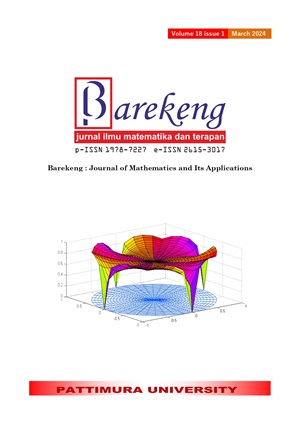RAINFALL FORECASTING OF SALT PRODUCING AREAS IN PANGKEP REGENCY USING STATISTICAL DOWNSCALING MODEL WITH LINEARIZED RIDGE REGRESSION DUMMY
Abstract
Pangkep Regency is one of the regions in South Sulawesi that is the center of national salt production. Salt production in the area is still dependent on sea water evaporation so that rainfall is one of the determining factors for the success of salt productivity. Statistical downscaling is an accurate method for rainfall forecasting by linking the local scale rainfall in Pangkep Regency (response variable) with the global scale of the global circulation model/GCM output (predictor variable). However, the GCM output rainfall has a large dimension, which is an 8×8 grid (64 predictor variables), causing multicollinearity. The linearized ridge regression (LRR) method is used to overcome this problem. This method combines the performance of generalized ridge regression and Liu-type methods to reduce multicollinearity. In addition, dummy variables based on the K-means clustering technique were added to the model to overcome heteroscedasticity. The purpose of this study is to obtain the results of rainfall forecasting in Pangkep Regency using the LRR method in the statistical downscaling model. The model generated from the LRR method with dummy variables is better at explaining the variability of rainfall in Pangkep Regency. The value is higher (72%) than without dummy variables (57%). The addition of dummy variables in the LLR model has better accuracy in forecasting rainfall. The actual rainfall correlation of Pangkep Regency with has the largest correlation (0.76) with the smallest mean absolute percentage error value (0.49). The results obtained are that the months of May - November tend to have relatively low rainfall, so that salt farmers can produce salt with good quantity and quality.
Downloads
References
M. E. Akbariansyah, N. Arvian, R. Avesta, and P. Arsitektur, “Adaptasi Desain Pada Tritisan Perumahan Minimalis Sesuai Iklim Tropis di Indonesia,” vol. VII, no. 1, pp. 11–18, 2019.
A. A. Ashilah, A. Wirasatriya, and G. Handoyo, “Analisis Variabel Fisika Perairan Terhadap Kuantitas Produksi Garam di Kabupaten Rembang,” Indones. J. Oceanogr., vol. 04, no. 02, pp. 68–76, 2022, [Online]. Available: https://data.remss.com/smap/
S. Sahriman, A. Kalondeng, and V. Koerniawan, “Pemodelan Statistical Downscaling Dengan Peubah Dummy Berdasarkan Teknik Cluster Hierarki Dan Non- Hierarki Untuk Pendugaan Curah Hujan,” Indones. J. Stat. Its Appl., vol. 3, no. 3, pp. 295–309, 2019, doi: 10.29244/ijsa.v3i3.471.
T. Listyarini, “Pemerintah Jadikan Sulsel Pusat Produksi Garam,” www.beritasatu.com, 2017. https://www.beritasatu.com/news/446948/pemerintah-jadikan-sulsel-pusat-produksi-garam (accessed Jul. 26, 2022).
N. P. M. S. Wahyuni, I. W. SUMARJAYA, and I. G. A. M. Srinadi, “Peramalan Curah Hujan Menggunakan Metode Analisis Spektral,” E-Jurnal Mat., vol. 5, no. 4, p. 183, 2016, doi: 10.24843/mtk.2016.v05.i04.p139.
Statistik KKP, “Data Produksi Garam.” statistik.kkp.go.id
R. M. Paramita and J. Mukono, “Hubungan Kelembapan Udara dan Curah Hujan dengan Kejadian Demam Berdarah Dengue di Puskesmas Gunung Anyar 2010-2016,” no. August, pp. 202–212, 2017, doi: 10.20473/ijph.v12i1.2017.202-212.
BMKG, “Tren Curah Hujan,” bmkg.go.id. https://www.bmkg.go.id/iklim/?p=tren-curah-hujan
N. Afnisa, “Peramalan Curah Hujan di Kota Medan Menggukan Metode Fuzzy Time Series,” Skripsi, 2019.
S. Gajbhiye, C. Meshram, S. K. Singh, P. K. Srivastava, and T. Islam, “Precipitation trend analysis of Sindh River basin, India, from 102-year record (1901-2002),” Atmos. Sci. Lett., vol. 17, no. 1, pp. 71–77, 2016, doi: 10.1002/asl.602.
S. Sahriman, Anisa, and V. Koerniawan, “Liu-type regression in statistical downscaling models for forecasting monthly rainfall salt as producer regions in Pangkep regency,” J. Phys. Conf. Ser., vol. 1341, no. 9, 2019, doi: 10.1088/1742-6596/1341/9/092021.
A. H. Wigena, A. Djuraidah, and S. Sahriman, “Statistical Downscaling Dengan Pergeseran Waktu Berdasarkan Korelasi Silang,” Jurnal Meteorologi dan Geofisika, vol. 16, no. 1. 2015. doi: 10.31172/jmg.v16i1.259.
IPCC, “What is a GCM?,” www.ipcc-data.org. https://www.ipcc-data.org/guidelines/pages/gcm_guide.html
D. Araya-Osses, A. Casanueva, C. Román-Figueroa, J. M. Uribe, and M. Paneque, “Climate change projections of temperature and precipitation in Chile based on statistical downscaling,” Clim. Dyn., vol. 54, no. 9–10, pp. 4309–4330, 2020, doi: 10.1007/s00382-020-05231-4.
V. R. Asyeifa, “Pemodelan Statistical Downscaling Dengan Projection Pursuit Regression Untuk Meramalkan Curah Hujan Bulanan Di Sentra Produksi Padi Jawa Timur,” Inst. Negeri 10 Nop., p. 83, 2017, [Online]. Available: http://repository.its.ac.id/47825/
M. Adam, “Pemodelan Linearized Ridge Regression Pada Data Yang Mengandung Multikolinearitas,” 2021, [Online]. Available: http://repository.unhas.ac.id/id/eprint/11578/%0Ahttp://repository.unhas.ac.id/id/eprint/11578/2/H051171304_skripsi_01-11-2021 Bab 1-2.pdf
R. P. Putra, D. Anggraeni, and A. F. Hadi, “Projection Pursuit Regression (PPR) on Statistical Downscaling Modeling for Daily Rainfall Forecasting,” Indones. J. Stat. Its Appl., vol. 5, no. 2, pp. 326–332, 2021, doi: 10.29244/ijsa.v5i2p326-332.
S. Sahriman and A. S. Yulianti, “Statistical Downscaling Model With Principal Component Regression and Latent Root Regression To Forecast Rainfall in Pangkep Regency,” BAREKENG J. Ilmu Mat. dan Terap., vol. 17, no. 1, pp. 0401–0410, 2023, doi: 10.30598/barekengvol17iss1pp0401-0410.
E. Supriyadi, S. Mariani, and Sugiman, “Perbandingan Metode Partial Least Square ( Pls ) Dan,” Unnes J. Math., vol. 6, no. 2, pp. 117–128, 2017.
A. Datumaya Wahyudi Sumari et al., “Perbandingan Kinerja Metode-Metode Prediksi pada Transaksi Dompet Digital di Masa Pandemi,” Masa Berlaku Mulai, vol. 4, no. 4, pp. 642–647, 2020.
Copyright (c) 2024 Sitti Sahriman, Eunike Laurine Randa, Sitti Aisyah Surianda, M. Zaky Gozhi Hisyam, Muh. Ikbal Taufik, Guntur Dwi Putra

This work is licensed under a Creative Commons Attribution-ShareAlike 4.0 International License.
Authors who publish with this Journal agree to the following terms:
- Author retain copyright and grant the journal right of first publication with the work simultaneously licensed under a creative commons attribution license that allow others to share the work within an acknowledgement of the work’s authorship and initial publication of this journal.
- Authors are able to enter into separate, additional contractual arrangement for the non-exclusive distribution of the journal’s published version of the work (e.g. acknowledgement of its initial publication in this journal).
- Authors are permitted and encouraged to post their work online (e.g. in institutional repositories or on their websites) prior to and during the submission process, as it can lead to productive exchanges, as well as earlier and greater citation of published works.






1.gif)



